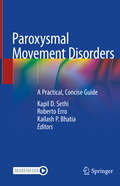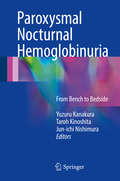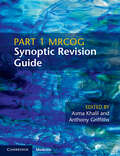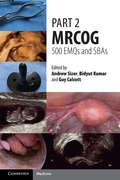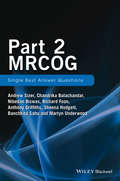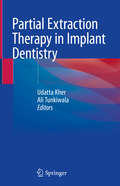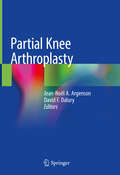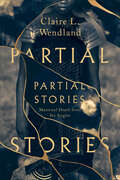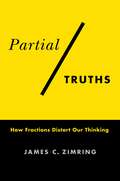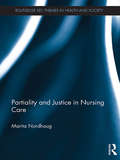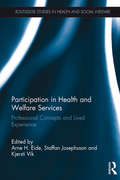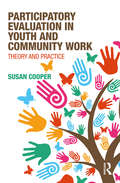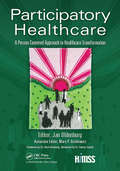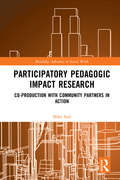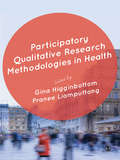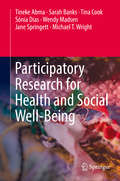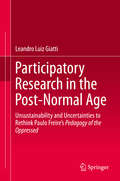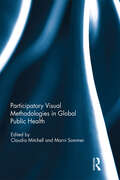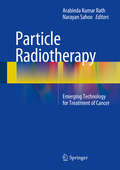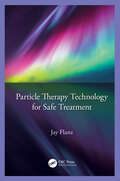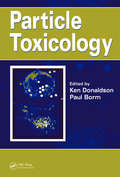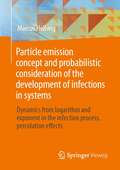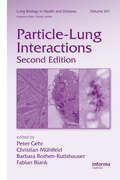- Table View
- List View
Paroxysmal Movement Disorders: A Practical, Concise Guide
by Kailash P. Bhatia Roberto Erro Kapil D. SethiThis book addresses the challenges in the differential diagnosis and management of paroxysmal movement disorders. It provides the latest information on the genetics and pathophysiology, neurophysiology and neuroimaging of the core group of disorders in the field, namely the paroxysmal dyskinesias (PxD).Focused and concise, this guide features chapters that discuss other conditions that may be paroxysmal such as, episodic ataxia, startle syndromes and other more complicated groups of paroxysmal movement disorders such as ATP1A3 spectrum disorders. A chapter on secondary (acquired) paroxysmal dyskinesia highlights medical and other disorders that may result in paroxysmal dyskinesia. The book features a particularly nuanced chapter that discusses recent discoveries in the genetic aspects of PxD, relaying that paroxysmal dyskinesias are not channelpathies, but in fact are synaptophies and transportopathies. Additionally, expertly written chapters are supplemented by high quality images, tables, and videos. Paroxysmal Movement Disorders: A Practical Guide is primarily written to educate the reader on how to make a syndromic diagnosis of paroxysmal movement disorders and how to build the diagnostic work-up accordingly, as well as how to manage patients with paroxysmal movement disorders.
Paroxysmal Nocturnal Hemoglobinuria
by Yuzuru Kanakura Taroh Kinoshita Jun-Ichi NishimuraParoxysmal Nocturnal Hemoglobinuria: From Bench to Bedside, reviews the fundamental understanding of this potentially life-threatening disease and the advances in treatment that have been achieved with the use of the monoclonal antibody, eculizumab. But while the PIGA gene has been identified for many years, the mechanism of clonal dominance in paroxysmal nocturnal hemoglobinuria is still largely unknown. This book discusses the direction of continuing research in this area, as well as the potential for the development of management guidelines. It serves as a valuable source of information for both basic scientists and physicians, especially immunologists targeting GPI-anchored proteins and complements, and hematologists specializing in bone marrow failure.
Part 1 MRCOG Synoptic Revision Guide
by Anthony Griffiths Asma KhalilConfidently tackle the MRCOG Part 1 exam with this comprehensively updated revision guide, reflecting the latest changes to the curriculum and question format. Edited by experienced examiners and written by course lecturers, the full syllabus is summarised using their extensive knowledge of the exam. Topics covered include the anatomy of the pelvic area, data interpretation in gynaecology and obstetrics, and the pathology of neoplastic and non-neoplastic diseases amongst others. Collections of single best answer (SBA) questions for several topics provide an invaluable opportunity for readers to test their retention of knowledge and practice for the exam. Bullet point formatting is used, enabling readers to absorb key information quickly. Over 200 illustrations aid understanding and engage the reader in the material being discussed, leading to a deeper appreciation of the topic. This is an indispensable revision guide for all MRCOG Part 1 candidates.
Part 2 MRCOG: 500 EMQs and SBAs
by Andrew Sizer Bidyut Kumar Guy CalcottThe more you practice, the better you get. Written by an experienced team of Member, Royal College of Obstetricians and Gynaecologists (MRCOG) question setters, this book contains 500 practice single best answer questions (SBAs) and extended matching questions (EMQs) for candidates undertaking the Part 2 MRCOG examination. It includes detailed explanations and key references to enable candidates to understand the reasoning and knowledge base behind the questions. All modules of the core curriculum are included, and detailed further sources are recommended for the inquisitive learner. The candidate can test their knowledge across the breadth of modules and identify areas for improvement and further revision. Following the 2015 format change to include SBAs, this book equips candidates with a full range of testing to develop familiarity with the format and prepare for high examination standards. Up to date, comprehensive and written by highly experienced examiners, this is a crucial resource for all Part 2 MRCOG candidates.
Part 2 MRCOG: Single Best Answer Questions
by Andrew Sizer Anthony Griffiths Chandrika Balachandar Nibedan Biswas Richard Foon Sheena Hodgett Banchhita Sahu Martyn UnderwoodPart 2 MRCOG: SBA Questions contains invaluable preparation and practice for candidates undertaking the Royal College of Obstetricians and Gynaecologists Part 2 MRCOG examination. It contains 400 practice questions written by a highly experienced team of MRCOG question writers, alongside detailed answers referencing each question to either an RCOG, NICE or WHO guideline, or an article in the professional journal ‘The Obstetrician & Gynaecologist’. This will enable candidates to understand the reasoning and knowledge base behind the question, as well as giving them a clear reference should they wish to read further around the subject. The first part of the book introduces and explains the new format of the Part 2 MRCOG exam, giving insightful advice on the skills required to write a good SBA question. The second part of the book contains chapters matched to the 15 of the 19 modules of the core curriculum, giving a comprehensive range of questions and answers with detailed explanations and references. For anyone preparing for the Part 2 MRCOG exam, this book will provide extensive and comprehensive practice and guidance from an expert author team.
Part 3 MRCOG
by Lisa Joels Edmund NealeWritten by two experienced RCOG examiners, both of whom have been involved in the development of the new Part 3 MRCOG examination, this book is essential reading for any trainee preparing to sit the exam. The authors clearly describe the breadth and depth of the curriculum modules and the professional behaviours that will be assessed in the five clinical skills domains. The text includes written examples of every module, links to eight videos showing candidates attempting four real Part 3 tasks, examiners' comments, and a detailed discussion of each example. The content will help candidates understand what is required to pass the examination and how to demonstrate their knowledge and skills to best effect. The book will also be useful for trainers preparing their trainees for the new exam. Based on the principles of good medical practice, there are practical tips here for doctors and obstetricians at all levels.
Partial Extraction Therapy in Implant Dentistry
by Udatta Kher Ali TunkiwalaThis book covers all clinical aspects of partial extraction therapy (PET), a revolutionary technique that offers long-term stability of soft and hard tissue around implants. Readers will find step-by-step protocols, valuable insights, and helpful tips, backed by the best available scientific evidence. After explanation of the biological rationale for PET, the socket shield technique, which entails partial extraction of the tooth root prior to implant placement, is clearly described and illustrated. Guidance is then provided on case selection, contraindications, and fabrication and design of the provisional restoration. Variations in the PET procedure are explained, and techniques presented for the management of multirooted teeth, pontic sites, and full mouth rehabilitation. Advice is also offered on how to deal with complications and treatment failures. Finally, the current evidence for PET and the scope for extending its use are reviewed. PET has gained immense popularity in recent years, and this book will be of value for clinicians, students, and academicians.
Partial Knee Arthroplasty
by Jean-Noël A. Argenson David F. DaluryThis book offers a concise review and international perspective on state-of-the art unicompartmental knee reconstruction procedures. To apply less invasive procedures resulting in fewer complications and shorter recoveries, it provides insights on patient selection, equipment design, and surgical techniques. Newer concepts such as the use of robotics and haptic surgery as well as outpatient surgeries are natural extensions of these surgeries. Long term outcomes along with complications and future directions are discussed as well. Partial Knee Arthroplasty presents an ideal resource for the occasional partial knee arthroplastic surgeon to the expert interested in international and contemporary advances in partial knee replacement.
Partial Stories: Maternal Death from Six Angles
by Claire L. WendlandA close look at stories of maternal death in Malawi that considers their implications in the broader arena of medical knowledge. By the early twenty-first century, about one woman in twelve could expect to die of a pregnancy or childbirth complication in Malawi. Specific deaths became object lessons. Explanatory stories circulated through hospitals and villages, proliferating among a range of practitioners: nurse-midwives, traditional birth attendants, doctors, epidemiologists, herbalists. Was biology to blame? Economic underdevelopment? Immoral behavior? Tradition? Were the dead themselves at fault? In Partial Stories, Claire L. Wendland considers these explanations for maternal death, showing how they reflect competing visions of the past and shared concerns about social change. Drawing on extended fieldwork, Wendland reveals how efforts to legitimate a single story as the authoritative version can render care more dangerous than it might otherwise be. Historical, biological, technological, ethical, statistical, and political perspectives on death usually circulate in different expert communities and different bodies of literature. Here, Wendland considers them together, illuminating dilemmas of maternity care in contexts of acute change, chronic scarcity, and endemic inequity within Malawi and beyond.
Partial Truths: How Fractions Distort Our Thinking
by James C. ZimringA fast-food chain once tried to compete with McDonald’s quarter-pounder by introducing a third-pound hamburger—only for it to flop when consumers thought a third pound was less than a quarter pound because three is less than four. Separately, a rash of suicides by teenagers who played Dungeons and Dragons caused a panic in parents and the media. They thought D&D was causing teenage suicides—when in fact teenage D&D players died by suicide at a much lower rate than the national average. Errors of this type can be found from antiquity to the present, from the Peloponnesian War to the COVID-19 pandemic. How and why do we keep falling into these traps?James C. Zimring argues that many of the mistakes that the human mind consistently makes boil down to misperceiving fractions. We see slews of statistics that are essentially fractions, such as percentages, probabilities, frequencies, and rates, and we tend to misinterpret them. Sometimes bad actors manipulate us by cherry-picking data or distorting how information is presented; other times, sloppy communicators inadvertently mislead us. In many cases, we fool ourselves and have only our own minds to blame. Zimring also explores the counterintuitive reason that these flaws might benefit us, demonstrating that individual error can be highly advantageous to problem solving by groups. Blending key scientific research in cognitive psychology with accessible real-life examples, Partial Truths helps readers spot the fallacies lurking in everyday information, from politics to the criminal justice system, from religion to science, from business strategies to New Age culture.
Partiality and Justice in Nursing Care (Routledge Key Themes in Health and Society)
by Marita NordhaugPartiality and Justice in Nursing Care examines the conflicting normative claims of partiality and impartiality in nursing care, looking in depth at how to reconcile reasonable concerns for one particular patient with equally important concerns for the maximisation of health-related welfare for all with relevant nursing-care needs, in a resource-limited setting. Drawing on moral philosophy, this book explores how discussions of partiality and impartiality in moral philosophy can have relevance to the professional context of clinical nursing care as well as in nursing ethics in general. It develops a framework for normative nursing ethics that incorporates a notion of permissible partiality, and specifies which concerns an ethics of nursing care should entail when balancing partialist and impartialist concerns. At the same time, Nordhaug argues that this partiality must also be constrained by both principled and context-sensitive assessments of patients’ needs, as well as of the role-relative deontological restriction of minimising harm, something that could be mitigated by institutional and organisational arrangements. This thought-provoking volume is an important contribution to nursing ethics and philosophy.
Participation in Health and Welfare Services: Professional Concepts and Lived Experience (Routledge Studies in Health and Social Welfare)
by Arne H. Eide Staffan Josephsson Kjersti VikToday, healthy ageing and active, meaningful lives are core values and aims for international and national health policies. Health services are challenged to ensure that the recipients of their services are active participants in their own care and beyond. Participation allows patients to become less dependent on healthcare providers, increasing their control over their own treatment and health. Increasingly, the idea of ‘participation’ is shifting, from participation in services to participation in mainstream society. This book examines the concept of participation, as well as the different meanings it takes on in the context of health and welfare services. It asks how services can enable and stimulate participation outside of those services. The contributions in this volume particularly focus on participation as engagement in daily life and ‘everyday life’ in order to develop the field of participation beyond the sphere of health and social care services. This book will appeal to researchers in the fields of health and social care, social services, occupational therapy and the sociology of health and illness. It will be of interest to practitioners of health and welfare services.
Participatory Evaluation in Youth and Community Work: Theory and Practice
by Susan CooperEvaluation is an essential element of professional practice. However, there is little in the literature that is designed to help students involve and support young people in evaluating the impact of youth work activities. This comprehensive book explores current thinking about evaluation in the context of youth work and community work and offers both theoretical understanding and practical guidance for students, practitioners, organisational leaders and commissioners. Part 1 provides underpinning knowledge of the origins, purpose and functions of evaluation. It charts the developments in evaluation thinking over the past 50 years, and includes an exploration of ‘theory of change’. Concepts such as impact, impact measurement and shared measurement are critically examined to illustrate the political nature of evaluation. Findings from empirical research are used to illuminate the challenges of applying a quasi-experimental paradigm of evaluation of youth and community work. Part 2 introduces the reader to participatory evaluation and presents an overview of the histories, rationale and underpinning principles. Empowerment evaluation, collaborative evaluation and democratic evaluation are examined in detail, including practice examples. Transformative Evaluation, an approach specifically designed for youth and community work, is presented. Part 3 focuses on the ‘doing’ of participatory evaluation and offers guidance to those new to participatory evaluation in youth and community work and a helpful check for those already engaging. It provides valuable information on planning, methods, data and data analysis and processes for sharing knowledge. This essential text will enable the reader to reconstruct evaluation as a tool for learning as well as a tool for judging value. It provides a comprehensive reference, drawing on a wide range of literature and practice examples to support those involved in youth and community work to develop and implement participatory approaches to evaluating and communicating the meaning and value of youth and community work to a wider audience.
Participatory Healthcare: A Person-Centered Approach to Healthcare Transformation (HIMSS Book Series #2)
by Jan Oldenburg Mary P. GriskewiczThis book is written through the lens of patients, caregivers, healthcare representatives and families, highlighting new models of interaction between providers and patients and what people would like in their healthcae experience. It will envision a new kind of healthcare system that recommends on how/why providers must connect to patients and families using HIT, as well as suggestions about new kinds of HIT capabilities and how they would redesign systems of care if they could. The book will emphasize best practices, and case studies, drawing conclusions about new models of care from the stories and input of patients and their families reienforced with clinical research.
Participatory Pedagogic Impact Research: Co-production with Community Partners in Action (Routledge Advances in Social Work)
by Mike SealInvolvement of community partners in the structure and design of services is largely accepted in principle, but its practice is heavily contested. This book argues that the co-production of research is one of the best ways to involve community partners. As well as having intrinsic value in and of itself, research embeds a culture of learning, co-production and of valuing research within organizations. It also creates a mechanism for developing evidence for, monitoring and evaluating subsequent ideas and initiatives that arise from other co-production initiatives. The book makes a case for research to be a synthesis of participatory research, critical pedagogy, peer research and community organizing. It develops a model called Participatory Pedagogic Impact Research (PPIR). Participatory research is often criticized for not having the impact it promises. PPIR ensures that the issues chosen, and the recommendations developed, serve the mutual self-interest of stakeholders, are realistic and realizable. At the same time this approach pushes the balance of power towards the oppressed using methods of dissemination that hold decision makers to account and create real change. PPIR also develops a robust method for creatively identifying issues, methods and analytic frameworks. Its third section details case studies across Europe and the United States of PPIR in action with professional researchers’ and community partners’ reflections on these experiences. This book gives a unique articulation of what makes for genuinely critical reflective spaces, something underdeveloped in the literature. It should be considered essential reading for both participatory research academics and those involved in health and social care services in the planning, commissioning and delivery of services.
Participatory Qualitative Research Methodologies in Health
by Pranee Liamputtong Gina HigginbottomThis guide to the essentials of doing participatory methods in a broad range of health contexts covers all of the stages of the research process, from research design right through to dissemination. With chapters from international contributors, each with many years’ experience using participatory qualitative approaches, it provides guidance on. - Ethical issues in Participatory Research - Designing and conduction Participatory Research projects - Data management and analysis - Researching with different populations - New technologies Packed full of up to date and engaging case studies, Participatory Qualitative Research Methodologies in Health offers a wide range of perspectives and voices on the practicalities and theoretical issues involved in conducting participatory research today. It is the ideal resource for students and researchers embarking upon a participatory research project.
Participatory Qualitative Research Methodologies in Health
by Pranee Liamputtong Gina HigginbottomThis guide to the essentials of doing participatory methods in a broad range of health contexts covers all of the stages of the research process, from research design right through to dissemination. With chapters from international contributors, each with many years’ experience using participatory qualitative approaches, it provides guidance on. - Ethical issues in Participatory Research - Designing and conduction Participatory Research projects - Data management and analysis - Researching with different populations - New technologies Packed full of up to date and engaging case studies, Participatory Qualitative Research Methodologies in Health offers a wide range of perspectives and voices on the practicalities and theoretical issues involved in conducting participatory research today. It is the ideal resource for students and researchers embarking upon a participatory research project.
Participatory Research for Health and Social Well-Being
by Sarah Banks Wendy Madsen Jane Springett Michael T. Wright Tineke Abma Tina Cook Sónia DiasThis textbook is a comprehensive guide for students interested in using participatory research to improve people’s health and well-being. It is especially designed for those working in the fields of health and social welfare who are embarking on participatory research for the first time. It covers all phases in participatory research from “getting started,” to “acting for change,” “continuing the journey” and “articulating impact.” Its unique format helps readers understand the essence of participatory research as a comprehensive approach for doing research which is underpinned by a set of fundamental values.The many real life examples of participatory research projects from around the world inspire readers to find creative ways to manage their own research while opening up new horizons in their work.
Participatory Research in the Post-Normal Age: Unsustainability and Uncertainties to Rethink Paulo Freire's Pedagogy of the Oppressed
by Leandro Luiz GiattiThis book shows how participatory research can provide tools to overcome the current epistemic and ethical challenges faced by traditional scientific approaches. Ever since Funtowicz and Ravetz proposed the notion of post-normal science, there has been a growing awareness of the limits of a form of knowledge production based only on the traditional scientific peer communities that excludes other social groups affected by its results and applications. The growing uncertainty and complexity posed by socio-ecological issues in the interactions between science, society and decision making has revealed the importance of a social quality control over crucial decisions that rely on scientific research and the necessary democratization of knowledge to tackle sustainability and health concerns.Departing from a reinterpretation of Paulo Freire’s Pedagogy of the Oppressed, this volume shows how participatory research can contribute to reconnect science and society by extending peer communities through the incorporation of different forms of knowledge and different social actors into research projects. To do so, the author presents a critical review of different participatory research approaches, identifying the elements that distinguish a true participatory research from a traditional one, and proposing a taxonomy of the various participatory methodologies. The volume also analyzes a diversity of social practices and understandings that deal with an ecology of knowledge and its systemic characteristics. Moreover, it demonstrates that uncertainties can be integrated in dialogical processes that open possibilities for a myriad of outcomes. Participatory Research in the Post-Normal Age - Unsustainability and Uncertainties to Rethink Paulo Freire's Pedagogy of the Oppressed will be of interest to researchers working with participatory approaches in different fields like health, environmental sciences, and education, as well as to practitioners of action research concerned with scientific dilemmas and counter-hegemonic strategies.
Participatory Visual Methodologies in Global Public Health
by Claudia Mitchell Marni SommerParticipatory Visual Methodologies in Global Public Health focuses on the use of participatory visual methodologies such as photovoice, participatory video (including cellphilming or the use of cell phones to make videos), drawing and mapping in public health research. These approaches are modes of inquiry that can engage participants and communities, eliciting evidence about their own health and well-being, as well as modes of representation and modes of production in the co-creation of knowledge, and modes of dissemination in relation to knowledge translation and mobilization. Thus, the production by a group of girls or young women of a set of photos or videos from their own visual perspective can offer new evidence on how, for example, they see sexual violence. Unlike other data such as those collected through surveys or even conventional interviews, the images they have produced not only inform the empirical evidence, but also do not need to remain in a laboratory or the office of a researcher. They can, through exhibitions and screenings, reach various audiences: school or health personnel, parents and community members, and perhaps also policy-makers. This collection offers a critical overview for students, practitioners, researchers and policy-makers working in or concerned with the use of participatory methodologies in public health around the globe. This book was originally published as a special issue of Global Public Health.
Particle Radiotherapy
by Arabinda Kumar Rath Narayan SahooThe results of decades of research and development are providing compelling evidence about the efficacy of radiation therapy with proton and carbon ion beams to achieve superior complication free tumor control leading to a world-wide rapid growth in their clinical use. This book contains comprehensive reviews of the state of the art of the technology and physics of heavy charge particle therapy by the experts from the leading cancer centers of world that will be valuable as a practical guide for radiation therapy professionals interested in these modalities.
Particle Therapy Technology for Safe Treatment
by Jay FlanzThe path from clinical requirements to technical implementation is filtered by the translation of the modality to the technology. An important part of that filter is that the modality be safe. For that to be the case, it is imperative to understand what clinical parameters affect the safety of a treatment and then determine how the technology can affect those parameters. This book provides a practical introduction to particle therapy. It provides a thorough introduction to the technological tools and their applications and then details the components that are needed to implement them. It explains the foundations of beam production and beam delivery that serve to meet the necessary clinical requirements. It emphasizes the relationship between requirements and implementation, including how safety and quality are considered and implemented in the solution. The reader will learn to better understand what parameters are important to achieve these goals. Particle Therapy Technology for Safe Treatment will be a useful resource for professionals in the field of particle therapy in addition to biomedical engineers and practitioners in the field of beam physics. It can also be used as a textbook for graduate medical physics and beam physics courses. Key Features Presents a practical and accessible journey from application requirements to technical solutions Provides a pedagogic treatment of the underlying technology Describes how safety is to be considered in the application of this technology and how safety and quality can be factored into the overall system Author Bio After receiving his PhD in nuclear physics, Dr. Jacob Flanz was the Accelerator Physics Group leader and Principal Research Scientist at the Massachusetts Institute of Technology (MIT), USA, where he designed the recirculator and the GeV stretcher/storage ring. He joined Massachusetts General Hospital (MGH) and Harvard and became project and technical director of proton therapy, with responsibility for specifications, integration, and commissioning ensuring safe clinical performance. He invented the universal nozzle and led the design and implementation of beam scanning at MGH in 2008, including quality assurance. Dr. Flanz has been involved in several FDA applications for particle therapy. He developed and taught the US Particle Accelerator School course "Medical Applications of Accelerators and Beams." He was cochair of education and is currently the president of the Particle Therapy Co-Operative Group.
Particle Toxicology
by Ken Donaldson Paul BormExposure to particles in industry and mining and from accidental anthropogenic sources constitutes an ongoing threat. Most recently nanoparticles arising from advances in technology are exposing a wider population to pathogenic stimuli. The effects of inhaled particles are no longer confined to the lung as nanoparticles have the potential to transl
Particle emission concept and probabilistic consideration of the development of infections in systems: Dynamics from logarithm and exponent in the infection process, percolation effects
by Marcus HellwigThe book describes the possibility of making a probabilistic prognosis, which uses the mean n-day logarithm of case numbers in the past to determine an exponent for a probability density for a prognosis, as well as the particle emission concept, which is derived from contact and distribution rates that increase the exponent of the probable development to the extent that a group of people can be formed.
Particle-Lung Interactions (Lung Biology in Health and Disease)
by Peter Gehr Barbara Rothen-Rutishauser MChristian MühlfeldWritten by an expanded team of leading international scientists, the second edition thoroughly investigates research and therapies for managing adverse physiological effects of air-borne particles on the respiratory tract. The book examines the lung as the gateway for particle damage to organs outside the respiratory system and provide the informat
